DSPL Şeması
Koleksiyonlar ile düzeninizi koruyun
İçeriği tercihlerinize göre kaydedin ve kategorilere ayırın.
Bu sayfa ve onun bağlantı verilen alt sayfaları, DSPL XML şemasını belgeler.
Bu materyal, ileri düzey kullanıcılar için hazırlanmıştır:
dilin alt düzey ayrıntıları; çoğu kullanıcı için
Geliştirici Kılavuzu, oluşturma ve düzenleme için yeterli olmalıdır
DSPL veri kümeleri.
XML şemasının tamamı XSD biçiminde indirilebilir
üzerinde
DSPL kod sitesi.
Öğe: dspl
| Ad alanı |
http://schemas.google.com/dspl/2010 |
| Ek açıklamalar |
Bir DSPL spesifikasyonu bir veri kümesini tanımlar. Veri kümesi
tarafından tanımlanan alan adını kullanın. Bir veri kümesi aşağıdakilerden oluşur
items: - Tablolar: Google Ads'de tanımlanan kavramlara ve dilimlere ilişkin veriler
Veri kümesi - Kavramlar:
veri kümesi - Dilimler:
veri kümesi - Konular: İşlevsellik kavramlarını organize etmek için kullanılan hiyerarşik etiketler
veri kümesi |
| Şema |
 |
| Özellikler |
|
| Model |
içe aktarma* , bilgi , sağlayıcı ,
özellik* , konular{0,1} , kavramlar{0,1} , dilimler{0,1} , tablolar{0,1} |
| Çocuklar |
özellik, kavramlar, içe aktarma,
bilgi, sağlayıcı, dilimler,
tablolar, konular |
| Örnek |
<dspl targetNamespace="">
<import location="" namespace="">{0,unbounded}</import>
<info>{1,1}</info>
<provider>{1,1}</provider>
<attribute concept="" id="">{0,unbounded}</attribute>
<topics>{0,1}</topics>
<concepts>{0,1}</concepts>
<slices>{0,1}</slices>
<tables>{0,1}</tables>
</dspl>
|
| Özellikler |
| QName |
Tür |
Düzeltildi |
Varsayılan |
Kullan |
Ek Açıklama |
| targetNamespace |
xs:anyURI |
|
|
isteğe bağlı |
Her veri kümesi bir hedef ad alanı sağlayabilir. Hedef
ad alanı, veri kümesini benzersiz şekilde tanımlayan bir URI'dır. Daha fazla
XML'de ad alanlarının kullanımıyla ilgili bilgileri inceleyin:
http://www.w3.org/TR/REC-xml-names/ targetNamespace yoksa
sağlanmışsa veri kümesiyle ilgili işlem yapıldığında bir ad alanı
içe aktarılmalıdır. |
|
| Kaynak |
<xs:element name="dspl">
<xs:annotation>
<xs:documentation>A DSPL specification describes a dataset. A dataset is
identified by its namespace. A dataset is comprised of the
following elements:
- Tables: Data for the concepts and slices defined in the
dataset
- Concepts: User-specified definitions and structures used in
the dataset
- Slices: Combinations of dimensions and metrics present in
the dataset
- Topics: Hierarchical labels used to organise the concepts of
the dataset</xs:documentation>
</xs:annotation>
<xs:complexType>
<xs:sequence>
<xs:element name="import" minOccurs="0" maxOccurs="unbounded">
<xs:annotation>
<xs:documentation>Import directive for external datasets -- modeled after
the XML Schema import directive. In order to use
elements defined in an external dataset, the external
dataset must be referenced using an import directive.</xs:documentation>
</xs:annotation>
<xs:complexType>
<xs:attribute name="namespace" use="required">
<xs:annotation>
<xs:documentation>The namespace of the imported dataset, specified as
a URI. A prefix must be associated with this
namespace before its contents can be referenced. See
[XML Namespaces] for more information about the use
of namespaces and prefixes in XML.</xs:documentation>
</xs:annotation>
</xs:attribute>
<xs:attribute name="location" use="optional">
<xs:annotation>
<xs:documentation>An optional location where the definition of the
imported dataset can be found, specified as a
URL. If the location is omitted, the system
processing this DSPL dataset must already know the
imported dataset.
Implementation note: The Google dataset importer
ignores the location attribute. Any imported dataset
must be known by the Google importer beforehand.</xs:documentation>
</xs:annotation>
</xs:attribute>
</xs:complexType>
</xs:element>
<xs:element name="info" type="Info" minOccurs="1">
<xs:annotation>
<xs:documentation>General information about the dataset.</xs:documentation>
</xs:annotation>
</xs:element>
<xs:element name="provider" type="Info">
<xs:annotation>
<xs:documentation>General information about the dataset provider.</xs:documentation>
</xs:annotation>
</xs:element>
<xs:element name="attribute" type="Attribute" minOccurs="0" maxOccurs="unbounded">
<xs:annotation>
<xs:documentation>Attribute associated with the dataset.</xs:documentation>
</xs:annotation>
</xs:element>
<xs:element name="topics" minOccurs="0">
<xs:annotation>
<xs:documentation>A hierarchy of topics used to organize the contents of
the dataset. The order in which topics are given is
meaningful and should be respected by visualizations
that displays these topics.</xs:documentation>
</xs:annotation>
<xs:complexType>
<xs:sequence>
<xs:element name="topic" type="Topic" maxOccurs="unbounded"/>
</xs:sequence>
</xs:complexType>
</xs:element>
<xs:element name="concepts" minOccurs="0">
<xs:annotation>
<xs:documentation>A list of concepts defined in this dataset.</xs:documentation>
</xs:annotation>
<xs:complexType>
<xs:sequence>
<xs:element name="concept" type="Concept" maxOccurs="unbounded"/>
</xs:sequence>
</xs:complexType>
</xs:element>
<xs:element name="slices" minOccurs="0">
<xs:annotation>
<xs:documentation>A list of slices defined in this dataset.</xs:documentation>
</xs:annotation>
<xs:complexType>
<xs:sequence>
<xs:element name="slice" type="Slice" maxOccurs="unbounded"/>
</xs:sequence>
</xs:complexType>
</xs:element>
<xs:element name="tables" minOccurs="0">
<xs:annotation>
<xs:documentation>A list of tables defined in this dataset.</xs:documentation>
</xs:annotation>
<xs:complexType>
<xs:sequence>
<xs:element name="table" type="Table" maxOccurs="unbounded"/>
</xs:sequence>
</xs:complexType>
</xs:element>
</xs:sequence>
<xs:attribute name="targetNamespace" type="xs:anyURI" use="optional">
<xs:annotation>
<xs:documentation>Each dataset may provide a target namespace. The
target namespace is a URI that uniquely identifies the
dataset. For more information about the use of namespaces in XML,
see:
http://www.w3.org/TR/REC-xml-names/
If no targetNamespace is provided, then a namespace will be
generated when the dataset is imported.</xs:documentation>
</xs:annotation>
</xs:attribute>
</xs:complexType>
</xs:element>
|
Öğe: dspl / import
| Ad alanı |
http://schemas.google.com/dspl/2010 |
| Ek açıklamalar |
Harici veri kümeleri için içe aktarma yönergesi (XML'ye göre modellenir)
Şema içe aktarma yönergesi. Harici bir
harici veri kümesine bir içe aktarma işlemi kullanılarak referans
yönergesini inceleyin. |
| Şema |
 |
| Özellikler |
| içerik: |
karmaşık |
| MinOccurs: |
0 |
| maxOccurs: |
sınırsız |
|
| Özellikler |
| QName |
Tür |
Düzeltildi |
Varsayılan |
Kullan |
Ek Açıklama |
| konum |
|
|
|
isteğe bağlı |
İçe aktarılan tanımlayıcının tanımının yapıldığı isteğe bağlı bir yer
bulunabilir. Konum
atlandığında, bu DSPL veri kümesini işleyen sistem
içe aktarılan veri kümesi ile aynı değere sahiptir. Uygulama notu: Google veri kümesi
içe aktaran, konum özelliğini yoksayar. İçe aktarılan tüm veri kümeleri
önceden Google'ın ithalatçısı tarafından bilinmesi gerekir. |
| ad alanı |
|
|
|
zorunlu |
İçe aktarılan veri kümesinin ad alanı,
URI. Ön ek,
referans verilebilir. Daha fazla bilgi için [XML Ad Alanları] bölümüne bakın
ve ön eklerin kullanımıyla ilgili bilgileri
XML. |
|
| Kaynak |
<xs:element name="import" minOccurs="0" maxOccurs="unbounded">
<xs:annotation>
<xs:documentation>Import directive for external datasets -- modeled after
the XML Schema import directive. In order to use
elements defined in an external dataset, the external
dataset must be referenced using an import directive.</xs:documentation>
</xs:annotation>
<xs:complexType>
<xs:attribute name="namespace" use="required">
<xs:annotation>
<xs:documentation>The namespace of the imported dataset, specified as
a URI. A prefix must be associated with this
namespace before its contents can be referenced. See
[XML Namespaces] for more information about the use
of namespaces and prefixes in XML.</xs:documentation>
</xs:annotation>
</xs:attribute>
<xs:attribute name="location" use="optional">
<xs:annotation>
<xs:documentation>An optional location where the definition of the
imported dataset can be found, specified as a
URL. If the location is omitted, the system
processing this DSPL dataset must already know the
imported dataset.
Implementation note: The Google dataset importer
ignores the location attribute. Any imported dataset
must be known by the Google importer beforehand.</xs:documentation>
</xs:annotation>
</xs:attribute>
</xs:complexType>
</xs:element>
|
Öğe: dspl / info
| Ad alanı |
http://schemas.google.com/dspl/2010 |
| Ek açıklamalar |
Veri kümesi hakkında genel bilgiler. |
| Şema |
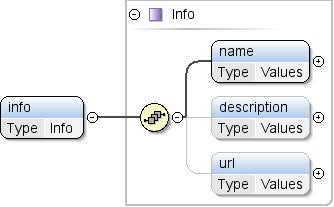 |
| Tür |
Bilgi |
| Özellikler |
| içerik: |
karmaşık |
| MinOccurs: |
1 |
|
| Model |
ad , açıklama{0,1} , url{0,1} |
| Çocuklar |
description, ad, url |
| Örnek |
<info>
<name>{1,1}</name>
<description>{0,1}</description>
<url>{0,1}</url>
</info>
|
| Kaynak |
<xs:element name="info" type="Info" minOccurs="1">
<xs:annotation>
<xs:documentation>General information about the dataset.</xs:documentation>
</xs:annotation>
</xs:element>
|
Öğe: dspl / provider
| Ad alanı |
http://schemas.google.com/dspl/2010 |
| Ek açıklamalar |
Veri kümesi sağlayıcısı hakkında genel bilgiler. |
| Şema |
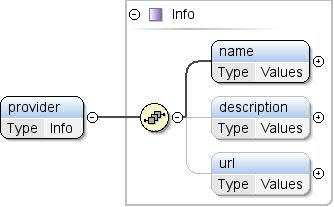 |
| Tür |
Bilgi |
| Özellikler |
|
| Model |
ad , açıklama{0,1} , url{0,1} |
| Çocuklar |
description, ad, url |
| Örnek |
<provider>
<name>{1,1}</name>
<description>{0,1}</description>
<url>{0,1}</url>
</provider>
|
| Kaynak |
<xs:element name="provider" type="Info">
<xs:annotation>
<xs:documentation>General information about the dataset provider.</xs:documentation>
</xs:annotation>
</xs:element>
|
Öğe: dspl / özellik
| Ad alanı |
http://schemas.google.com/dspl/2010 |
| Ek açıklamalar |
Veri kümesiyle ilişkilendirilen özellik. |
| Şema |
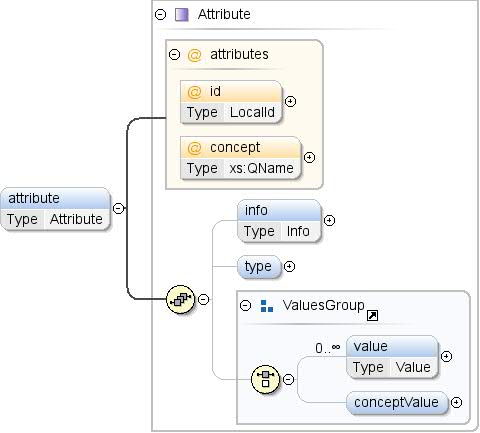 |
| Tür |
Özellik |
| Özellikler |
| içerik: |
karmaşık |
| MinOccurs: |
0 |
| maxOccurs: |
sınırsız |
|
| Model |
info{0,1} , type{0,1} , (değer*
| conceptValue{0,1}) |
| Çocuklar |
conceptValue, bilgi, tür,
değer |
| Örnek |
<attribute concept="" id="">
<info>{0,1}</info>
<type format="" ref="">{0,1}</type>
</attribute>
|
| Özellikler |
| QName |
Tür |
Düzeltildi |
Varsayılan |
Kullan |
Ek Açıklama |
| kavram |
xs:QName |
|
|
isteğe bağlı |
Değerlere karşılık gelen bir kavrama yapılan referans
içerir. Özellik bir tür belirtiyorsa tür,
başvuruda bulunulan kavramın türüyle eşleşmelidir. Bir
dış kavram şu biçimde olmalıdır:
"prefix:other_concept_id"; burada "ön ek" :
harici veri kümesinin ad alanı için kullanılan ön ek (bkz. XML)
ad alanları) ayırmanızı sağlar. |
| id |
LocalId |
|
|
isteğe bağlı |
Konsept özelliğinin kimliği. Bu tanımlayıcı
Kavram dahilinde benzersiz (özellikler ve özellikler genelinde) İlgili içeriği oluşturmak için kullanılan
Kavram özelliği belirtilirse id atlanabilir. Bu
durumda, kimlik, dizenin yerel adının değeri ile
referans verilen bir kavramdır. Örneğin, <attribute
concept="unit:currency"/> eşdeğerdir
<attribute id="currency"
concept="unit:currency"/> |
|
| Kaynak |
<xs:element name="attribute" type="Attribute" minOccurs="0" maxOccurs="unbounded">
<xs:annotation>
<xs:documentation>Attribute associated with the dataset.</xs:documentation>
</xs:annotation>
</xs:element>
|
Öğe: dspl / konular
| Ad alanı |
http://schemas.google.com/dspl/2010 |
| Ek açıklamalar |
İçeriklerin içeriğini düzenlemek için kullanılan konular hiyerarşisi
veri kümesiyle eşleştirilir. Konuların sıralanma sırası anlamlıdır ve
bu konuları gösteren görselleştirmelere saygı gösterir. |
| Şema |
 |
| Özellikler |
| içerik: |
karmaşık |
| MinOccurs: |
0 |
|
| Model |
konu+ |
| Çocuklar |
konu |
| Örnek |
<topics>
<topic id="" parentTopic="">{1,unbounded}</topic>
</topics>
|
| Kaynak |
<xs:element name="topics" minOccurs="0">
<xs:annotation>
<xs:documentation>A hierarchy of topics used to organize the contents of
the dataset. The order in which topics are given is
meaningful and should be respected by visualizations
that displays these topics.</xs:documentation>
</xs:annotation>
<xs:complexType>
<xs:sequence>
<xs:element name="topic" type="Topic" maxOccurs="unbounded"/>
</xs:sequence>
</xs:complexType>
</xs:element>
|
| Ad alanı |
http://schemas.google.com/dspl/2010 |
| Şema |
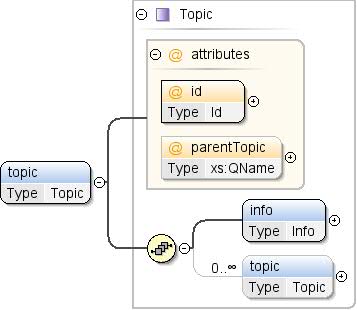 |
| Tür |
Konu |
| Özellikler |
| içerik: |
karmaşık |
| maxOccurs: |
sınırsız |
|
| Model |
info , konu* |
| Çocuklar |
info, konu |
| Örnek |
<topic id="" parentTopic="">
<info>{1,1}</info>
<topic id="" parentTopic="">{0,unbounded}</topic>
</topic>
|
| Özellikler |
| QName |
Tür |
Düzeltildi |
Varsayılan |
Kullan |
Ek Açıklama |
| id |
No |
|
|
zorunlu |
Konunun
veri kümesi olarak tanımlanır. |
| parentTopic |
xs:QName |
|
|
isteğe bağlı |
Bu konunun (varsa) ana konusunun kimliği.
içinde satır içi olan konular için parentTopic belirtilemez
göz atabilirsiniz. |
|
| Kaynak |
<xs:element name="topic" type="Topic" maxOccurs="unbounded"/>
|
Öğe: dspl / kavramlar
| Ad alanı |
http://schemas.google.com/dspl/2010 |
| Ek açıklamalar |
Bu veri kümesinde tanımlanan kavramların listesi. |
| Şema |
 |
| Özellikler |
| içerik: |
karmaşık |
| MinOccurs: |
0 |
|
| Model |
kavram+ |
| Çocuklar |
kavram |
| Örnek |
<concepts>
<concept extends="" id="">{1,unbounded}</concept>
</concepts>
|
| Kaynak |
<xs:element name="concepts" minOccurs="0">
<xs:annotation>
<xs:documentation>A list of concepts defined in this dataset.</xs:documentation>
</xs:annotation>
<xs:complexType>
<xs:sequence>
<xs:element name="concept" type="Concept" maxOccurs="unbounded"/>
</xs:sequence>
</xs:complexType>
</xs:element>
|
| Ad alanı |
http://schemas.google.com/dspl/2010 |
| Şema |
 |
| Tür |
Kavram |
| Özellikler |
| içerik: |
karmaşık |
| maxOccurs: |
sınırsız |
|
| Model |
info , topic* , type{0,1}
özellik* , özellik* , defaultValue{0,1} , tablo{0,1} |
| Çocuklar |
attribute, defaultValue, info,
özellik, tablo, konu,
tür |
| Örnek |
<concept extends="" id="">
<info>{1,1}</info>
<topic ref="">{0,unbounded}</topic>
<type ref="">{0,1}</type>
<attribute concept="" id="">{0,unbounded}</attribute>
<property concept="" id="" isMapping="false" isParent="false">{0,unbounded}</property>
<defaultValue>{0,1}</defaultValue>
<table ref="">{0,1}</table>
</concept>
|
| Özellikler |
| QName |
Tür |
Düzeltildi |
Varsayılan |
Kullan |
Ek Açıklama |
| uzamasını sağlar |
xs:QName |
|
|
isteğe bağlı |
Bu kavramın tanıttığı bir kavramın benzersiz tanımlayıcısı
uzatılır. Başvuruda bulunulan kavram, aynı veri kümesinde tanımlanabilir
(ör. başka bir veri kümesinde kullanabilirsiniz). Harici bir
Kavram "prefix:other_concept_id" biçiminde olmalıdır.
"ön ek" alan adı için kullanılan ön ektir
harici veri kümesi (XML ad alanlarına bakın). |
| id |
No |
|
|
zorunlu |
Konseptin benzersiz tanımlayıcısıdır.
global olarak benzersiz olması gerekir. |
|
| Kaynak |
<xs:element name="concept" type="Concept" maxOccurs="unbounded"/>
|
Öğe: dspl / dilimler
| Ad alanı |
http://schemas.google.com/dspl/2010 |
| Ek açıklamalar |
Bu veri kümesinde tanımlanan dilimlerin listesi. |
| Şema |
 |
| Özellikler |
| içerik: |
karmaşık |
| MinOccurs: |
0 |
|
| Model |
dilim+ |
| Çocuklar |
dilim |
| Örnek |
<slices>
<slice id="">{1,unbounded}</slice>
</slices>
|
| Kaynak |
<xs:element name="slices" minOccurs="0">
<xs:annotation>
<xs:documentation>A list of slices defined in this dataset.</xs:documentation>
</xs:annotation>
<xs:complexType>
<xs:sequence>
<xs:element name="slice" type="Slice" maxOccurs="unbounded"/>
</xs:sequence>
</xs:complexType>
</xs:element>
|
| Ad alanı |
http://schemas.google.com/dspl/2010 |
| Şema |
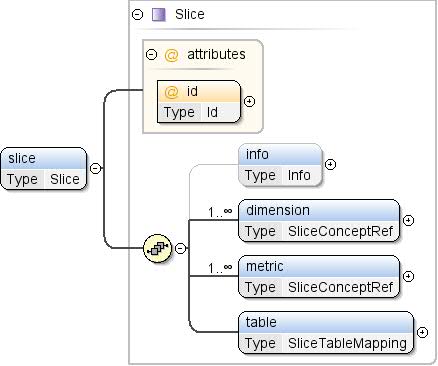 |
| Tür |
Dilim |
| Özellikler |
| içerik: |
karmaşık |
| maxOccurs: |
sınırsız |
|
| Model |
bilgi{0,1} , boyut+ , metrik+
, tablo |
| Çocuklar |
boyut, bilgi, metrik,
tablo |
| Örnek |
<slice id="">
<info>{0,1}</info>
<dimension concept="">{1,unbounded}</dimension>
<metric concept="">{1,unbounded}</metric>
<table ref="">{1,1}</table>
</slice>
|
| Özellikler |
| QName |
Tür |
Düzeltildi |
Varsayılan |
Kullan |
Ek Açıklama |
| id |
No |
|
|
zorunlu |
Dilimin benzersiz tanımlayıcısı. |
|
| Kaynak |
<xs:element name="slice" type="Slice" maxOccurs="unbounded"/>
|
Öğe: dspl / tablolar
| Ad alanı |
http://schemas.google.com/dspl/2010 |
| Ek açıklamalar |
Bu veri kümesinde tanımlanan tabloların listesi. |
| Şema |
 |
| Özellikler |
| içerik: |
karmaşık |
| MinOccurs: |
0 |
|
| Model |
tablo+ |
| Çocuklar |
tablo |
| Örnek |
<tables>
<table id="">{1,unbounded}</table>
</tables>
|
| Kaynak |
<xs:element name="tables" minOccurs="0">
<xs:annotation>
<xs:documentation>A list of tables defined in this dataset.</xs:documentation>
</xs:annotation>
<xs:complexType>
<xs:sequence>
<xs:element name="table" type="Table" maxOccurs="unbounded"/>
</xs:sequence>
</xs:complexType>
</xs:element>
|
| Ad alanı |
http://schemas.google.com/dspl/2010 |
| Şema |
 |
| Tür |
Tablo |
| Özellikler |
| içerik: |
karmaşık |
| maxOccurs: |
sınırsız |
|
| Model |
bilgi{0,1} , sütun+ , veriler{0,1} |
| Çocuklar |
sütun, veriler, bilgi |
| Örnek |
<table id="">
<info>{0,1}</info>
<column format="" id="" type="">{1,unbounded}</column>
<data>{0,1}</data>
</table>
|
| Özellikler |
| QName |
Tür |
Düzeltildi |
Varsayılan |
Kullan |
Ek Açıklama |
| id |
No |
|
|
zorunlu |
veri kümesi olarak tanımlanır. |
|
| Kaynak |
<xs:element name="table" type="Table" maxOccurs="unbounded"/>
|
Özellik: dspl / import / @namespace
| Ad alanı |
Ad alanı yok |
| Ek açıklamalar |
İçe aktarılan veri kümesinin, URI olarak belirtilen ad alanı. CEVAP
önekinin, içeriklerinin bu ad alanıyla ilişkilendirilmesi gerekir
referans alın.
ad alanları ve ön ekler ile çalışır. |
| Özellikler |
|
| Kullanan reklam sayısı |
|
| Kaynak |
<xs:attribute name="namespace" use="required">
<xs:annotation>
<xs:documentation>The namespace of the imported dataset, specified as
a URI. A prefix must be associated with this
namespace before its contents can be referenced. See
[XML Namespaces] for more information about the use
of namespaces and prefixes in XML.</xs:documentation>
</xs:annotation>
</xs:attribute>
|
| Ad alanı |
Ad alanı yok |
| Ek açıklamalar |
İçe aktarılan tanımlayıcının tanımının yapıldığı isteğe bağlı bir yer
bulunabilir. Konum atlanırsa
bu DSPL veri kümesini işleyen sistemin, içe aktarılan
veri kümesiyle eşleştirilir. Uygulama notu: Google veri kümesi içe aktarıcısı,
yer özelliği. İçe aktarılan tüm veri kümeleri Google tarafından bilinmelidir
önceden fark etmiş olmanız gerekir. |
| Özellikler |
|
| Kullanan reklam sayısı |
|
| Kaynak |
<xs:attribute name="location" use="optional">
<xs:annotation>
<xs:documentation>An optional location where the definition of the
imported dataset can be found, specified as a
URL. If the location is omitted, the system
processing this DSPL dataset must already know the
imported dataset.
Implementation note: The Google dataset importer
ignores the location attribute. Any imported dataset
must be known by the Google importer beforehand.</xs:documentation>
</xs:annotation>
</xs:attribute>
|
Özellik: dspl / @targetNamespace
| Ad alanı |
Ad alanı yok |
| Ek açıklamalar |
Her veri kümesi bir hedef ad alanı sağlayabilir. Hedef
ad alanı, veri kümesini benzersiz şekilde tanımlayan bir URI'dır. Daha fazla
XML'de ad alanlarının kullanımıyla ilgili bilgileri inceleyin:
http://www.w3.org/TR/REC-xml-names/ targetNamespace sağlanmazsa
veri kümesi şu şekilde olduğunda bir ad alanı oluşturulur:
içe aktarılmalıdır. |
| Tür |
xs:anyURI |
| Özellikler |
|
| Kullanan reklam sayısı |
|
| Kaynak |
<xs:attribute name="targetNamespace" type="xs:anyURI" use="optional">
<xs:annotation>
<xs:documentation>Each dataset may provide a target namespace. The
target namespace is a URI that uniquely identifies the
dataset. For more information about the use of namespaces in XML,
see:
http://www.w3.org/TR/REC-xml-names/
If no targetNamespace is provided, then a namespace will be
generated when the dataset is imported.</xs:documentation>
</xs:annotation>
</xs:attribute>
|
Oluşturulma:
oXygen XML Düzenleyici.
Aksi belirtilmediği sürece bu sayfanın içeriği Creative Commons Atıf 4.0 Lisansı altında ve kod örnekleri Apache 2.0 Lisansı altında lisanslanmıştır. Ayrıntılı bilgi için Google Developers Site Politikaları'na göz atın. Java, Oracle ve/veya satış ortaklarının tescilli ticari markasıdır.
Son güncelleme tarihi: 2025-07-25 UTC.
[[["Anlaması kolay","easyToUnderstand","thumb-up"],["Sorunumu çözdü","solvedMyProblem","thumb-up"],["Diğer","otherUp","thumb-up"]],[["İhtiyacım olan bilgiler yok","missingTheInformationINeed","thumb-down"],["Çok karmaşık / çok fazla adım var","tooComplicatedTooManySteps","thumb-down"],["Güncel değil","outOfDate","thumb-down"],["Çeviri sorunu","translationIssue","thumb-down"],["Örnek veya kod sorunu","samplesCodeIssue","thumb-down"],["Diğer","otherDown","thumb-down"]],["Son güncelleme tarihi: 2025-07-25 UTC."],[],["The DSPL XML schema defines a dataset's structure using key components: `tables`, `concepts`, `slices`, and `topics`. The root `dspl` element encapsulates the dataset, utilizing `import` to reference externals, `info` and `provider` for metadata, `attribute` for dataset attributes, and `topics` to hierarchically organize the concepts. `concepts`, `slices`, `tables` are for concept definition, slice definition, and data table, respectively. Each element like `import`, `info`, `provider`, `attribute`, `topic`, `concept`, `slice`, `table` uses specific attributes and child elements for configuration. Each element has a specific cardinality that is defined in the document.\n"]]













